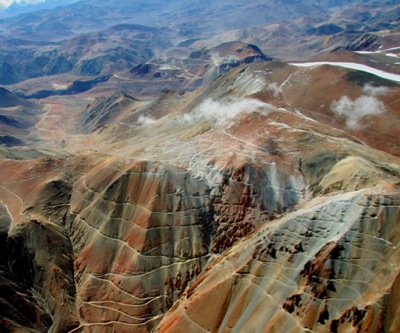Barrick mothballs Pascua-Lama

Top gold miner Barrick Gold (NYSE:ABX TSE:ABX) yesterday reported financial results that showed a drop in production, further trimming of capex and costs, new directors and a quarterly loss.
Toronto-based Barrick also confirmed its troubled Pascua Lama project in South America is now on care and maintenance after the company spent $300 million to complete the ramp-down of the project which straddles the Chilean-Argentinian border.
Barrick gold stopped construction of Pascua Lama in October as part of its cost and debt-reduction program. The company, worth $23 billion on the TSX, has already spent $5 billion on the project which could have a final bill in excess of $8.5 billion after a series of cost overruns.
But any decision to restart Pascua Lama seems far off, judging by the carefully worded statement accompanying the company’s financials:
A decision to restart development will depend on improved economics and reduced uncertainty related to legal and regulatory requirements. To improve execution and cost control, remaining development will take place in distinct stages with specific work programs and budgets. Barrick continues to explore opportunities to improve the project’s risk-adjusted returns, including strategic partnerships or royalty and other income streaming agreements.
During the second quarter, Barrick signed a Memorandum of Understanding (MoU) with a group of 15 Diaguita indigenous communities and associations in Chile’s Huasco province. The MoU marks a first step in establishing dialogue and working to build trust with members of this important stakeholder group. As part of the MoU, Barrick will make technical and environmental information about the Pascua-Lama project available to the communities and provide financial resources and materials required to support analysis of this information.
The technically and politically challenging project high in the Andes launched in 2006 (at the time initial capex costs were pegged at $1.5 billion), suffered a number of defeats in Chilean courts about water use and the impact on glaciers in the area.
In contrast Argentina has been a vigorous backer of the project.
While only around a fifth of the deposit is located in Argentina many of the above-ground facilities will be built on that side of the border. Barrick earlier this year laid off 1,500 of the 5,000 workers on the Argentinian side.
If, and it’s a big if, Pascua Lama goes into production the mine is expected to produce about 800,000 to 850,000 ounces of gold and 35 million ounces of silver in the first five years of its 25 year life.
Pascua Lama is also the subject of a class action lawsuit filed last month on behalf of investors who acquired Barrick stock between May 7, 2009 and May 23, 2013.
Shares in the $21.3 billion company lost 44% of its value over that time period, with a large chunk of the losses coming in April and May last year when the Toronto-based firm tapped markets for $3 billion to pay down debts.
The class actions allege that Barrick Gold shareholders lost billions of dollars as a result of Barrick’s “misrepresentations and failures” regarding the stalled project.
{{ commodity.name }}
{{ post.title }}
{{ post.date }}




4 Comments
Mark
Well good for Barrick, no point bringing all that cheap gold out of the ground when they’re not going to make much money on it. When the pricing environment returns, you can bet that Pascua Lama will be brought into production.
Jorge Daniel Taillant
Pascua Lama WILL NEVER get off the ground because it is in DIRECT VIOLATION of Argentina’s Glacier Protection Law … and soon, Chile will also have a firm law in place … these are the “legal” issues that the company is struggling with.
Daniel Miranda
I wonder if the brains trust at Barrick in Toronto every figured out if they can get any money out of Argentina. Given they way the Argentine debt problems are going whats the bet if they ever start up the job it will be nationalized as fast as you can say “YPF”. But I am sure they thought of that along with many other things.
Firdaus Abbasi
I suggest that it has little appetite to understand it’s foreign ops outside North America. Like Pascua Lama, Tanzania & Barrick Africa is case to point out. I had written on this a month ago.
There seems to be continued lack of coherence between the operations and within the operations. The cost overruns is now a regular theme since early 2000s. It is not a problem of accountants and lawyers as some suggest…